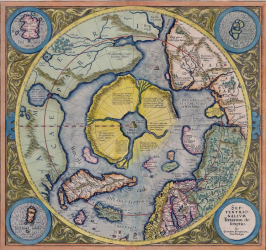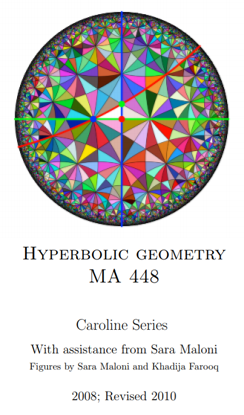https://youtu.be/ChcUMvo1x_A
Softology – DLA – LBM – Snowflake – Cellular Automata
Caroline Series – Hyperbolic Geometry, Perspective and Time
Medieval Perspective
When we Look with our Eyes and not with our Mind we can See that Space looks very different from what we Think it is. In Our Space Parallel Lines meet at Infinity.
Around 1400 during the Renaissance Painters started to look at Space with their own Eyes and discovered the Rules of Perspective Drawing.
Between 1600-1800 Perspective Theory changed from a Theory of Art to a Theory of Mathematics called Projective Geometry.
It took 400 Years before a few Mathematicians realized that Projective Geometry was the Foundation of Mathematics and it took another 100 years before Projective Geometry started to influence Physics.
In 1908 Hermann Minkowski discovered that Einstein’s Theory of Special Relativity could be analysed using Projective Geometry. Minkowski created a 4D Space-Time Metric Geometry in which he added one Time Dimension.
Many experiments now show that 4D-Space-Time is not sufficient to incorporate what Time Really is.
Continue reading “Caroline Series – Hyperbolic Geometry, Perspective and Time”
Plato – Phaedrus – The First Critique of Writing – Ammon – Thoth
Plato’s Phaedrus (from Plato in Twelve Volumes, Vol. 9, translated by Harold N. Fowler. Cambridge, MA, Harvard University Press; London, William Heinemann Ltd. 1925. http://www.perseus.tufts.edu)
Socrates:[274c]
Well, this is what I’ve heard. Among the ancient gods of
Naucratis in Egypt there was one to whom the bird called the ibis is
sacred. The name of that divinity was Theuth and it was he who first
discovered number and calculation, geometry and astronomy, as well as the games of checkers and dice, and, above all else, writing.
Now the king of all Egypt at that time was Thamus, who lived in the
great city in the upper region that the Greeks call Egyptian Thebes; Thamus they call Ammon. Theuth came to exhibit his arts to him and urged him to disseminate them to all the Egyptians. Thamus asked him about the usefulness of each art, and while Theuth was explaining it, Thamus praised him for whatever he thought was right in his explanations and criticized him for whatever he thought was wrong.
The story goes that Thamus said much to Theuth, both for and against
each art, which it would take too long to repeat. But when they came to
writing, Theuth said: “0 King, here is something that, once learned, will
make the Egyptians wiser and will improve their memory; I have discovered a potion for memory and for wisdom.”
Thamus, however, replied: “0 most expert Theuth, one man can give birth to the elements of an art, but only another can judge how they can benefit or harm those who will use them. And now, since you are the father of writing, your affection for it has made you describe its effects as the opposite of what they really are.
In fact, it will introduce forgetfulness into the soul of those who learn it: they will not practice using their memory because they will put their trust in writing, which is external and depends on signs that belong to others, instead of trying to remember from the inside, completely on their own.
You have not discovered a potion for remembering. but for reminding; you provide your students with the appearance of wisdom, not with its reality. Your invention will enable them to hear many things without being properly taught, and they will imagine that they have come to know much while for the most part they will know nothing. And they will be difficult to get along with, since they will merely appear to be wise instead of really being so.”
Phaedrus:
Socrates, you’re very good at making up stories from Egypt or wherever else you want!
Socrates:
But, my friend, the priests of the temple of Zeus at Dodona say that the first prophecies were the words of an oak. Everyone who lived at that time, not being as wise as you young ones are today, found it rewarding enough in their simplicity to listen to an oak or even a stone, so long as it was telling the truth, while it seems to make a difference to you, Phaedrus, who is speaking and where he comes from. Why, though, don’t you just consider whether what he says is right or wrong?
Jan Saenredam – The Allegory of the Cave
 The Allegory of the Cave From The Republic of Plato
The Allegory of the Cave From The Republic of Plato
Compare our nature in respect of education and its lack to such an
experience as this. People live under the earth in a cavelike dwelling. Stretching a long way up toward the daylight is its entrance, toward which the entire cave is gathered. The people have been in this dwelling since childhood, shackled by the legs and neck.. Thus they stay in the same place so that there is only one thing for them to look that: whatever they encounter in front of their faces. But because they are shackled, they are unable to turn their heads around.
A fire is behind them, and there is a wall between the fire and the prisoners
Some light, of course, is allowed them, namely from a fire that casts its glow toward them from behind them, being above and at some distance. Between the fire and those who are shackled there runs a walkway at a certain height. Imagine that a low wall has been built the length of the walkway, like the low curtain that puppeteers put up, over which they show their puppets.
The images carried before the fire
So now imagine that all along this low wall people are carrying all sorts of things that reach up higher than the wall: statues and other carvings made of stone or wood and many other artifacts that people have made. As you would expect, some are talking to each other and some are silent.
From the beginning people like this have never managed, whether
on their own or with the help by others, to see anything besides the shadows that are projected on the wall opposite them by the glow of the fire.
Now if they were able to say something about what they saw and to talk it over, do you not think that they would regard that which they saw on the wall as beings?
And now what if this prison also had an echo reverberating off the wall in front of them ? Whenever one of the people walking behind those in chains would make a sound, do you think the prisoners would imagine that the speaker were anyone other than the shadow passing in front of them?
——————————————————————————————–
Artist: Jan Saenredam was born in Zaandam, c. 1565. Orphaned in childhood, he was raised by an uncle, Pieter de Jongh, a bailiff in Assendelft. Though brought up for a life of farm labour and handiwork, he turned to drawing and in time attained some success as a mapmaker. With the help of a local lawyer, he entered the circle of Hendrick Goltzius relatively late in life, in 1589, and worked for short periods with both Goltzius and Jacques de Gheyn II. Saenredam was one of Goltzius’ most important masters and worked closely with him, creating a major body of work. According to both de Bie and Schrevelius, there was some rivalry between each of these masters and Saenredam, who quickly absorbed what they had to offer him. About 1595 Saenredam returned to Assendelft, where he married and where his son Pieter, who later became famous for his paintings of the interiors of churches, was born. He died in Assendelft in 1607.
In Graven Images: The Rise of Professional Printmakers in Antwerp and Haarlem, 1540-1640, ed. Timothy Riggs and Larry Silver (Evanston: Mary and Leigh Block Gallery, Northwestern University, 1993), Riggs describes Saenredam’s “most characteristic engraving style” as “similar to Goltzius’ but more delicate, with silver tones and silky textures,” as exemplified in The Expulsion from Eden after Abraham Bloemaert and The Foolish Virgins (both of which are illustrated in Graven Images and each of which will be found in the pages devoted to Saenredam on our website). Silver, in a chapter on “Goltzius as Evolutionary Reproductive Engraver,” suggests that “the most important engraver after Goltzius was Jan Saenredam. . . . Saenredam began as Goltzius’ apprentice and produced his first engravings in 1589 but he soon left after Goltzius criticism to work with his fellow apprentice de Gheyn in Amsterdam for a couple of years. He then set up his own production shop for prints after Goltzius and other, younger designers, especially Bloemaert. . . . Saenredam followed the Goltzius lead in making prints after similar designers: Polidoro da Caravaggio, Cornelis van Haarlem, and an elaborate variant of his own on Goltzius’ beached whale. Saenredam, too, promoted the Lucas van Leyden revival in his prints. He made engravings in 1600 after two surviving Lucas drawings: Jael and Judith. . . . ” Silver points out that Saenredam’s work after Goltzius (B. 40-103) extended for almost a full decade, and frequently included cycles, particularly allegories of The Four Seasons, The Times of Day [see under Allegories], The Five Senses, The Seven Planets, and even The Three Kinds of Marriage [see under Allegories]. In addition, Saenredam also frequently produced images of mythic deities after Goltzius, sometimes with an emblematic or allegorical message.













